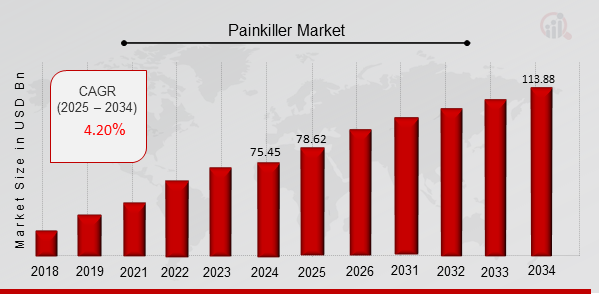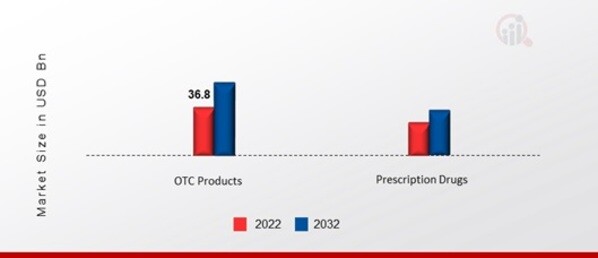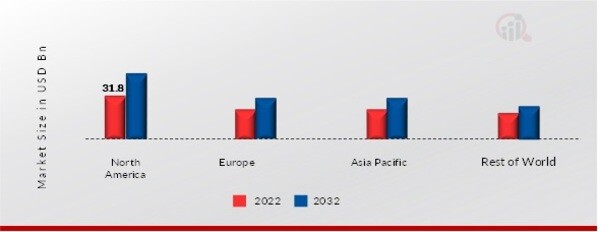Global Painkiller Market Overview
As per MRFR analysis, the Painkiller Market Size was estimated at 75.45 (USD Billion) in 2024. The Painkiller Market Industry is expected to grow from 78.62 (USD Billion) in 2025 to 113.88 (USD Billion) till 2034, at a CAGR (growth rate) is expected to be around 4.20% during the forecast period (2025 - 2034). Increase in chronic pain cases and advancements in drug delivery is a key market drivers enhancing the market growth.

Source: Secondary Research, Primary Research, Market Research Future Database and Analyst Review
Painkiller Market Trends
Increase in chronic pain cases is driving the market growth
The painkiller market is propelled by a significant increase in chronic pain cases worldwide. Factors such as an aging population, sedentary lifestyles, and the prevalence of chronic conditions contribute to the growing demand for effective pain management solutions. Chronic pain, associated with conditions like arthritis, neuropathy, and musculoskeletal disorders, prompts individuals to seek relief through Painkillers. This trend is driving pharmaceutical companies to develop and market a diverse range of Painkillers, including opioids, non-opioids, and alternative therapies.
The rise in chronic pain cases underscores the necessity for accessible and efficient pain management options, making the Painkiller market a critical component of healthcare as it addresses the evolving needs of individuals dealing with persistent pain.
The painkiller market is the growing interest in cannabinoids, particularly cannabidiol (CBD). Cannabinoids have gained recognition for their potential in pain management, offering an alternative to traditional Painkillers. The anti-inflammatory and analgesic properties of cannabinoids make them appealing for individuals seeking natural and non-opioid pain relief. This trend has led to the development of CBD-infused pain relief products, including oils, creams, and capsules.
As regulatory environments become more favorable and public awareness increases, the demand for cannabinoid-based Painkillers continues to rise, contributing to the expansion and diversification of the Painkiller market with innovative and potentially more sustainable approaches to pain management.
Advancements in drug delivery are playing a pivotal role in propelling the Painkiller market forward. Innovations in drug delivery systems, such as transdermal patches, sustained-release formulations, and targeted delivery mechanisms, enhance the efficacy and convenience of pain management. These technologies aim to provide more controlled and long-lasting relief, improving patient adherence and overall outcomes. The development of novel delivery methods contributes to the optimization of Painkiller administration, addressing issues like dosage control and minimizing side effects.
As pharmaceutical companies invest in research and development for sophisticated drug delivery systems, the market responds to the increasing demand for safer, more efficient, and patient-friendly pain management solutions, fostering the growth of the Painkiller market.
For instance, as outlined by the India Brand Equity Foundation, projections indicate that the healthcare sector in India is anticipated to reach a valuation of USD 372 billion by 2022. Key factors contributing to this growth include increasing income levels, improved health awareness, a rise in the prevalence of lifestyle diseases, and improved access to insurance. Thus, driving the Painkiller market revenue.
Painkiller Market Segment Insights:
Painkiller Drug Class Insights
The Painkiller market segmentation, based on drug class includes Opioids, Tramadol, Oxycodone, Hydrocodone, Other Opioids, NSAIDs, Local Anesthetics and Acetaminophen. Local anesthetics, as a drug class, have captured the largest market share in the Painkiller market due to their widespread use in various medical procedures and surgeries. These drugs provide targeted pain relief by blocking nerve signals in specific areas, making them highly effective for localized pain management. Their versatility and applicability in dental, dermatological, and minor surgical procedures contribute to their dominant market share.
Additionally, local anesthetics are commonly used in inpatient and outpatient settings, further solidifying their position as the leading drug class in the Painkiller market.
Painkiller Product Insights
The Painkiller market segmentation, based on product, includes OTC Products and Prescription Drugs. The OTC products segment secured the largest market share in the Painkiller market due to their accessibility and widespread consumer use. OTC Painkillers, including acetaminophen and nonsteroidal anti-inflammatory drugs (NSAIDs) like ibuprofen, are readily available without a prescription, allowing consumers to self-manage mild to moderate pain. The convenience, familiarity, and perceived safety of OTC Painkillers contribute to their dominant market share, as individuals often opt for these products for immediate relief from common ailments such as headaches, muscle pain, and minor injuries.
Figure 1: Painkiller Market, by Product, 2022 & 2032 (USD Billion)

Source: Secondary Research, Primary Research, Market Research Future Database and Analyst Review
Painkiller Indication Insights
The Painkiller market segmentation, based on indication, includes Surgical Pain, Cancer Pain, Neuropathic Pain, Musculoskeletal and Joint Pain and Others. Surgical pain indication has captured the largest market share in the Painkiller market due to the prevalence of surgical procedures requiring effective postoperative pain management. Patients undergoing surgeries often experience varying degrees of pain, necessitating potent Painkillers for relief. The demand for analgesics in surgical settings, encompassing both major and minor surgeries, contributes significantly to the dominance of the surgical pain indication.
Additionally, advancements in surgical techniques and an increase in elective procedures further drive the utilization of Painkillers in this specific market segment.
Painkiller Route of Administration Insights
The Painkiller market segmentation, based on route of administration, includes Injectable, Oral, Rectal, Topical, Transdermal and Others. The oral category generated the most income (25%). Oral Painkillers, including tablets and capsules, are widely prescribed and available over-the-counter, making them accessible to a broad patient population. This route provides a practical and familiar method for pain management, contributing to its dominant market share. Additionally, advancements in formulation technologies have enhanced the efficacy of orally administered Painkillers, further solidifying their prominence.
Painkiller Distribution channel Insights
The Painkiller market segmentation, based on distribution channel, includes Hospital Pharmacies, Specialty Clinics, Long-Term Care Centers, Retail Pharmacies, Drug Stores and Online Pharmacies. Hospital pharmacies have captured the largest market share in the Painkiller market due to their role as major healthcare hubs where a wide range of Painkillers are dispensed. Hospitals serve as primary locations for surgeries, acute care, and specialized pain management, necessitating a diverse inventory of pain medications. Additionally, the presence of healthcare professionals facilitates accurate prescription and administration.
The centralized nature of hospital pharmacies, catering to both inpatient and outpatient needs, contributes to their dominance in distributing Painkillers.
Painkiller Regional Insights
By region, the study provides the market insights into North America, Europe, Asia-Pacific and Rest of the World. North America has secured the largest market share in the Painkiller market due to several factors. The region experiences a high prevalence of chronic pain conditions, contributing to substantial demand for pain management solutions. Additionally, well-established healthcare infrastructure, a strong emphasis on pain relief, and the availability of a wide range of Painkillers contribute to North America's dominance. Stringent regulations and the ongoing response to the opioid crisis also shape the Painkiller market landscape in this region.
Further, the major countries studied in the market report are The US, Canada, German, France, the UK, Italy, Spain, China, Japan, India, Australia, South Korea, and Brazil.
Figure 2: Painkiller Market Share By Region 2022 (USD Billion)

Source: Secondary Research, Primary Research, Market Research Future Database and Analyst Review
Europe Painkiller market accounts for the second-largest market share due to its well-developed healthcare systems, increasing awareness of pain management, and a high incidence of chronic pain conditions. The region's stringent regulatory framework ensures responsible prescribing practices, influencing the market landscape. Additionally, the growing aging population and advancements in medical treatments contribute to the demand for Painkillers. Europe's focus on patient care and adherence to safety standards positions it as a significant market player in pain management.
Further, the German Painkiller market held the largest market share, and the UK Painkiller market was the fastest growing market in the European region
The Asia-Pacific Painkiller Market is expected to grow at the fastest CAGR from 2025 to 2034 due to factors such as a rising population, increasing healthcare awareness, and a growing prevalence of chronic diseases. As healthcare infrastructure improves and access to medical services expands, the demand for pain management solutions surges. Additionally, changing lifestyles and an aging population contribute to the escalating need for Painkillers in the Asia Pacific region, driving its notable CAGR in the Painkiller market.
Moreover, China’s Painkiller market held the largest market share, and the Indian Painkiller market was the fastest growing market in the Asia-Pacific region.
Painkiller Key Market Players & Competitive Insights
Leading players in the Painkiller market, including pharmaceutical companies such as Pfizer, Johnson & Johnson, and Novartis, are focusing on research and development to innovate pain management solutions. Market developments are focused on development of novel analgesics, exploring alternative therapies, and addressing concerns related to opioid use. Additionally, strategic collaborations, mergers, and acquisitions are prevalent, enhancing market presence. These players are adapting to changing regulations, emphasizing responsible prescribing practices, and aligning with evolving healthcare trends to maintain a competitive edge in the dynamic Painkiller market.
Manufacturing locally to minimize operational costs is one of the key business tactics used by manufacturers in the Painkiller industry to benefit clients and increase the market sector. In recent years, the Painkiller industry has offered some of the most significant advantages to medicine. Major players in the Painkiller market, including Pfizer Inc., Johnson & Johnson, Novartis AG, GlaxoSmithKline plc, Bayer AG, Eli Lilly and Company, Sanofi S.A., Merck & Co., Inc., AstraZeneca plc, Teva Pharmaceutical Industries Ltd. and others, are attempting to increase market demand by investing in research and development operations.
Novartis AG, a pharmaceutical company, plays a significant role in the Painkiller market. The company is renowned for its innovative and diverse healthcare portfolio, which includes pain management solutions. Novartis is actively involved in research and development to introduce novel analgesics and address pain-related challenges. With a commitment to improving patient outcomes and enhancing quality of life, Novartis navigates the evolving landscape of pain management. The company's strategic focus on responsible prescribing practices, adherence to regulatory standards, and collaborative efforts contributes to its strong position in the competitive Painkiller market, providing effective and reliable solutions for patients ly.
Merck & Co., Inc., a leading pharmaceutical company, is a key player in the Painkiller market. Renowned for its commitment to advancing healthcare solutions, Merck offers a range of pain management medications. The company's focus on research and development drives the innovation of analgesics and alternative therapies. Merck emphasizes responsible prescribing practices, aligning with evolving regulations and healthcare trends. With a presence and a dedication to improving patient well-being, Merck remains at the forefront of providing effective and safe pain relief options. Collaborative efforts, strategic initiatives, and a comprehensive portfolio contribute to Merck's influential position in the competitive Painkiller market.
Key Companies in the Painkiller market include
- Pfizer Inc.
- Johnson & Johnson
- Novartis AG
- GlaxoSmithKline plc
- Bayer AG
- Eli Lilly and Company
- Sanofi S.A.
- Merck & Co., Inc.
- AstraZeneca plc
- Teva Pharmaceutical Industries Ltd.
Painkiller Market Industry Developments
- Q2 2024: NuVasive Launches Pulse Platform 2.0 to Advance Spine Surgery NuVasive announced the commercial launch of Pulse Platform 2.0, an integrated technology platform designed to enhance spinal fusion procedures with advanced imaging, navigation, and robotics capabilities.
- Q2 2024: Globus Medical Announces FDA Clearance and Launch of REFLECT™ Scoliosis Correction System Globus Medical received FDA clearance and launched the REFLECT™ Scoliosis Correction System, a non-fusion technology for treating adolescent idiopathic scoliosis, expanding its spinal solutions portfolio.
- Q2 2024: Medtronic Receives FDA Approval for UNiD™ Adaptive Spine Intelligence Platform Medtronic announced FDA approval for its UNiD™ Adaptive Spine Intelligence platform, which uses artificial intelligence to personalize spinal fusion surgery planning and improve patient outcomes.
- Q3 2024: Alphatec Holdings Completes Acquisition of SafeOp Surgical Alphatec Holdings completed the acquisition of SafeOp Surgical, a company specializing in neuromonitoring technology, to strengthen its intraoperative neuromonitoring capabilities for spinal fusion procedures.
- Q3 2024: Spineart Secures $100 Million Series E Funding to Accelerate U.S. Expansion Spineart, a developer of spinal fusion implants and technologies, raised $100 million in Series E funding to support its commercial expansion and R&D activities in the United States.
- Q3 2024: Orthofix Announces FDA Clearance for 7D FLASH Navigation System for Spinal Fusion Orthofix received FDA clearance for its 7D FLASH Navigation System, a machine-vision image guidance platform designed to improve accuracy and efficiency in spinal fusion surgeries.
- Q4 2024: Zimmer Biomet Launches ROSA® ONE Spine System in Europe Zimmer Biomet announced the European launch of the ROSA® ONE Spine System, a robotic platform designed to assist surgeons in performing complex spinal fusion procedures.
- Q4 2024: SeaSpine Announces Merger with Orthofix to Create Leading Spine and Orthopedics Company SeaSpine and Orthofix announced a definitive merger agreement to combine their businesses, aiming to create a leading global spine and orthopedics company with a broad spinal fusion product portfolio.
- Q1 2025: Stryker Receives CE Mark for Tritanium® C Anterior Cervical Cage Stryker received CE Mark approval for its Tritanium® C Anterior Cervical Cage, enabling the company to market the spinal fusion device in the European Union.
- Q1 2025: NuVasive Appoints New Chief Executive Officer NuVasive announced the appointment of a new Chief Executive Officer to lead the company’s next phase of growth in the spinal fusion and spine surgery market.
- Q2 2025: Medtronic Opens New Manufacturing Facility for Spinal Implants in Ireland Medtronic opened a new manufacturing facility in Ireland dedicated to producing spinal fusion implants, aiming to meet growing global demand and enhance supply chain resilience.
- Q2 2025: Globus Medical Launches Excelsius3D™ Imaging System for Spine Surgery Globus Medical launched the Excelsius3D™ imaging system, designed to provide advanced intraoperative imaging for spinal fusion and other spine procedures.
Painkiller Market Segmentation
Painkiller Drug Class Outlook
- Opioids
- Tramadol
- Oxycodone
- Hydrocodone
- Other Opioids
- NSAIDs
- Local Anesthetics
- Acetaminophen
Painkiller Product Outlook
- OTC Products
- Prescription Drugs
Painkiller Indication Outlook
- Surgical Pain
- Cancer Pain
- Neuropathic Pain
- Musculoskeletal and Joint Pain
- Others
Painkiller Route of Administration Outlook
- Injectable
- Oral
- Rectal
- Topical
- Transdermal
- Others
Painkiller Distribution Channel Outlook
- Hospital Pharmacies
- Specialty Clinics
- Long-Term Care Centers
- Retail Pharmacies
- Drug Stores
- Online Pharmacies
Painkiller Regional Outlook
| Report Attribute/Metric |
Details |
| Market Size 2024 |
75.45 (USD Billion) |
| Market Size 2025 |
78.62 (USD Billion) |
| Market Size 2034 |
113.88 (USD Billion) |
| Compound Annual Growth Rate (CAGR) |
4.20 % (2025 - 2034) |
| Report Coverage |
Revenue Forecast, Competitive Landscape, Growth Factors, and Trends |
| Base Year |
2024 |
| Market Forecast Period |
2025 - 2034 |
| Historical Data |
2020 - 2024 |
| Report Coverage |
Revenue Forecast, Market Competitive Landscape, Growth Factors, and Trends |
| Segments Covered |
Drug Class, Product, Indication, Route of Administration, Distribution Channel and Region |
| Geographies Covered |
North America, Europe, Asia Pacific, and the Rest of the World |
| Countries Covered |
The US, Canada, German, France, UK, Italy, Spain, China, Japan, India, Australia, South Korea, and Brazil |
| Key Companies Profiled |
Pfizer Inc., Johnson & Johnson, Novartis AG, GlaxoSmithKline plc, Bayer AG, Eli Lilly and Company, Sanofi S.A., Merck & Co., Inc., AstraZeneca plc, Teva Pharmaceutical Industries Ltd. |
| Key Market Opportunities |
· Advancements in drug delivery is an opportunity for the market |
| Key Market Dynamics |
· Increase Advancements in drug delivery are playing a pivotal role in propelling |
Frequently Asked Questions (FAQ):
The Painkiller market size was valued at USD 69.5 Billion in 2022.
The market is projected to grow at a CAGR of 4.20% during the forecast period, 2025-2034.
North America had the largest share in the market
The key players in the market are Pfizer Inc., Johnson & Johnson, Novartis AG, GlaxoSmithKline plc, Bayer AG, Eli Lilly and Company, Sanofi S.A., Merck & Co., Inc., AstraZeneca plc, Teva Pharmaceutical Industries Ltd. Company.
The hospital pharmacies category dominated the market in 2022.
The oral had the largest share in the Market

















